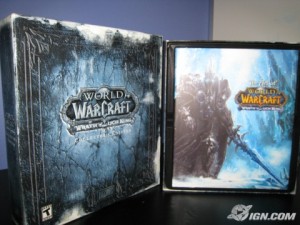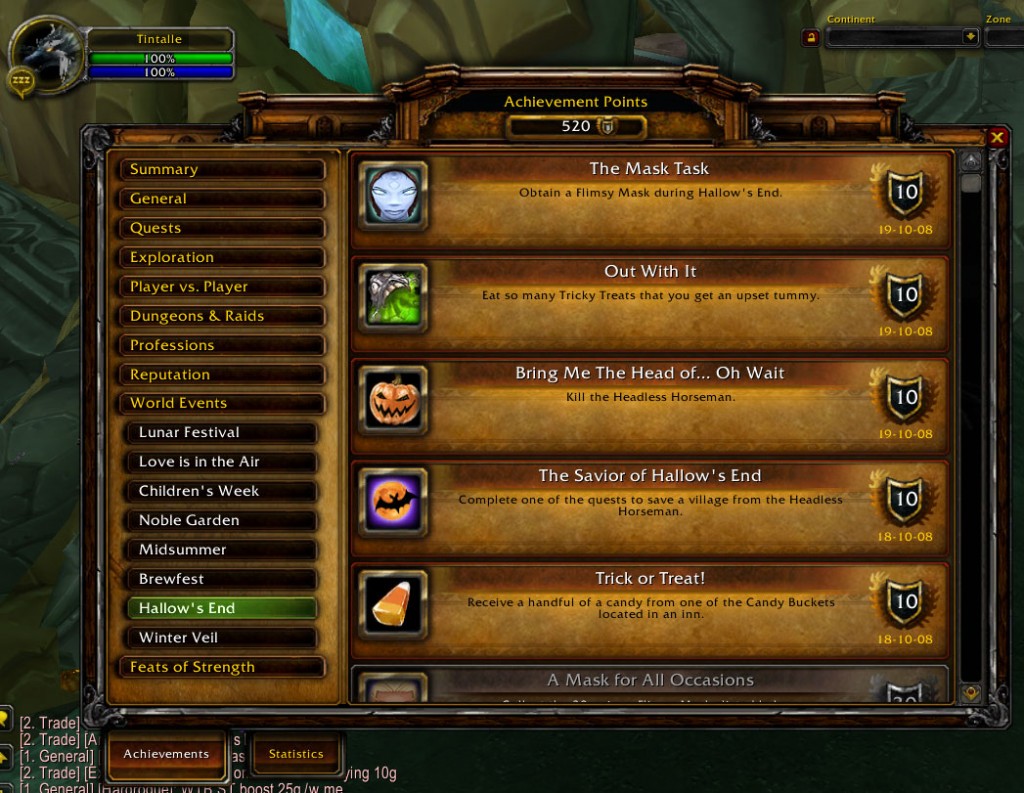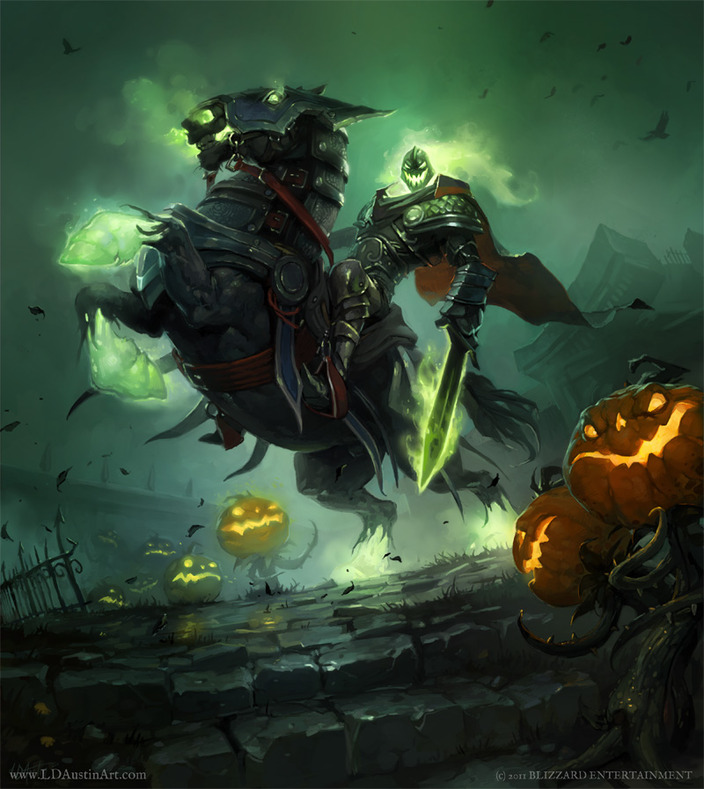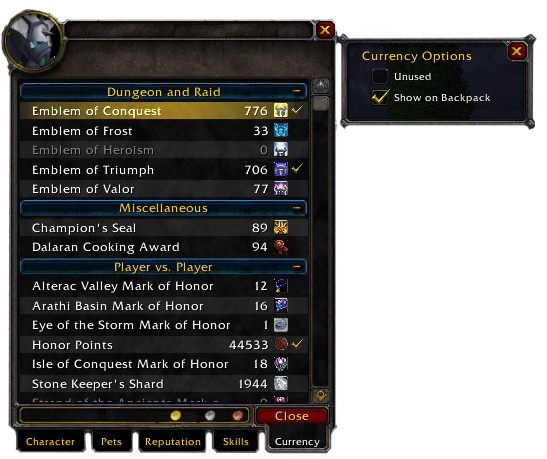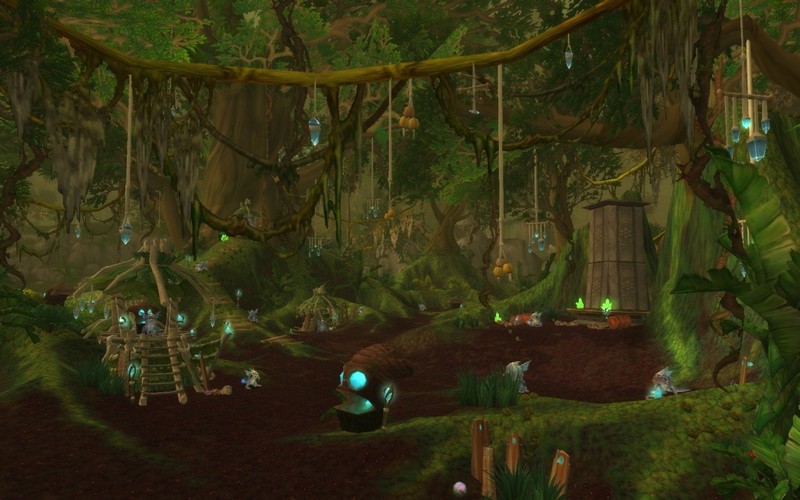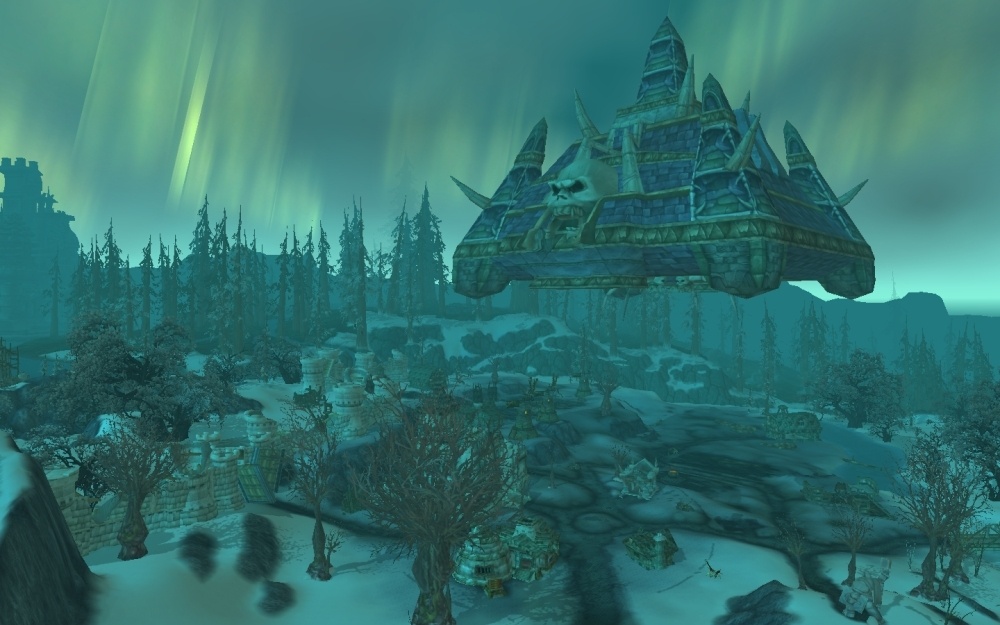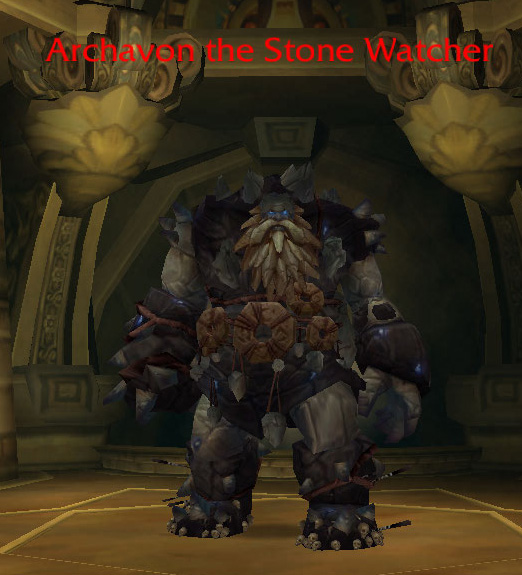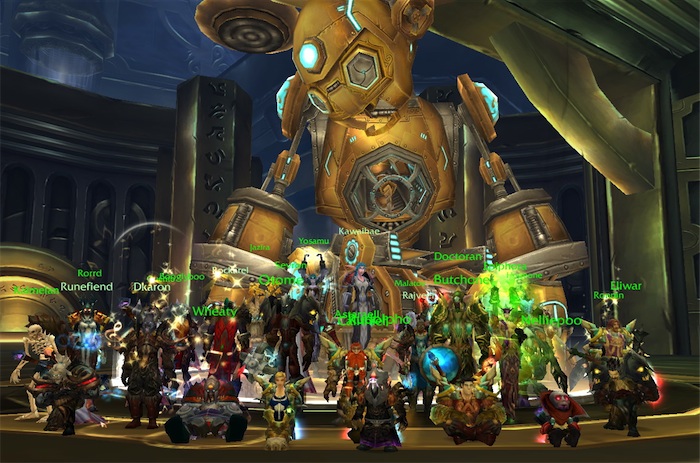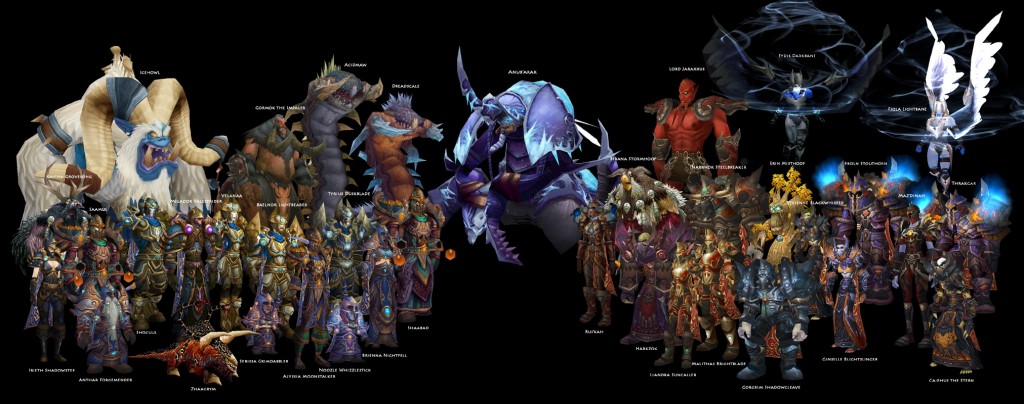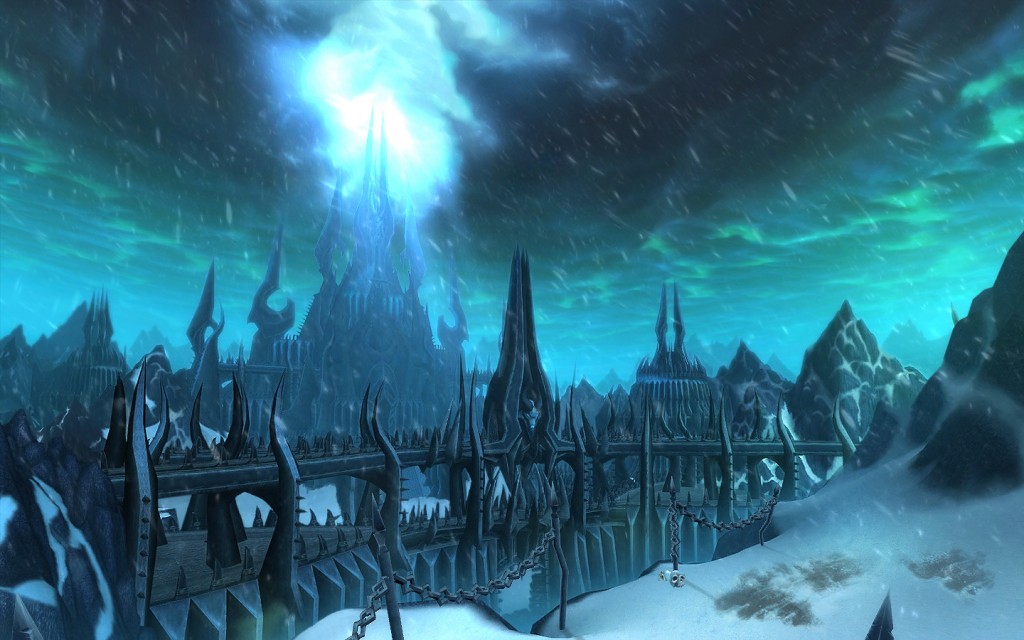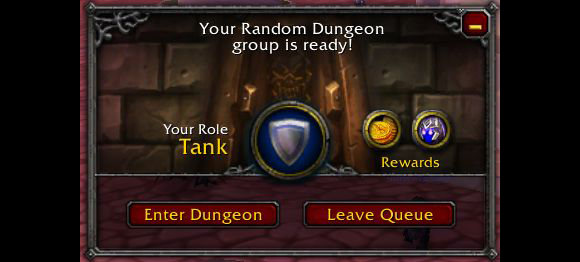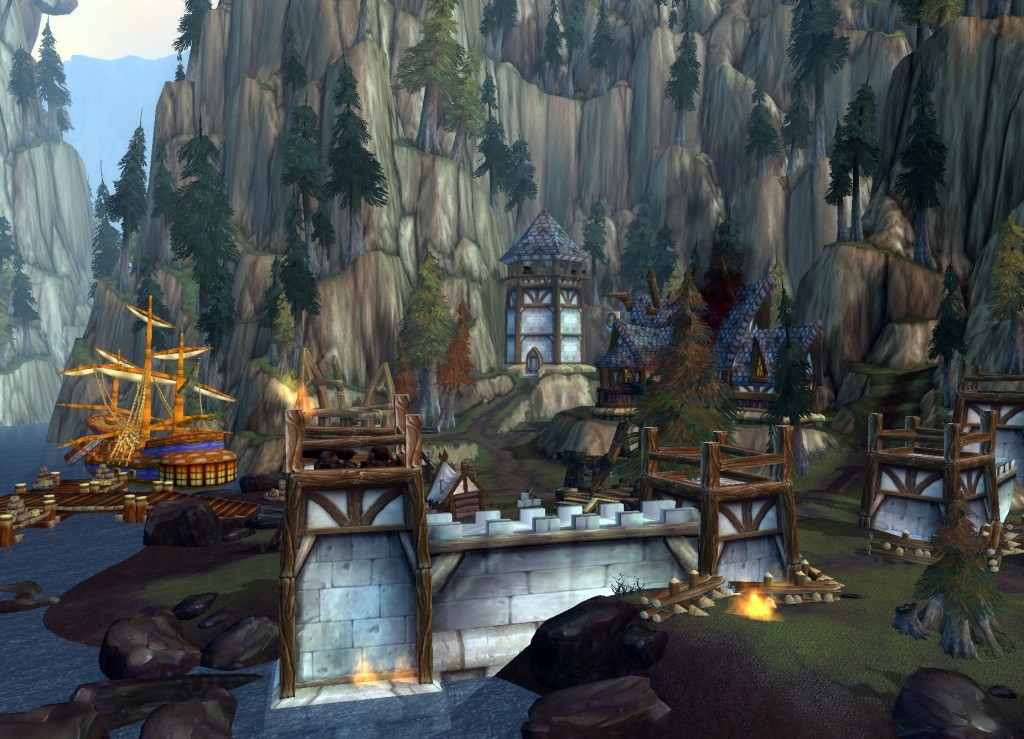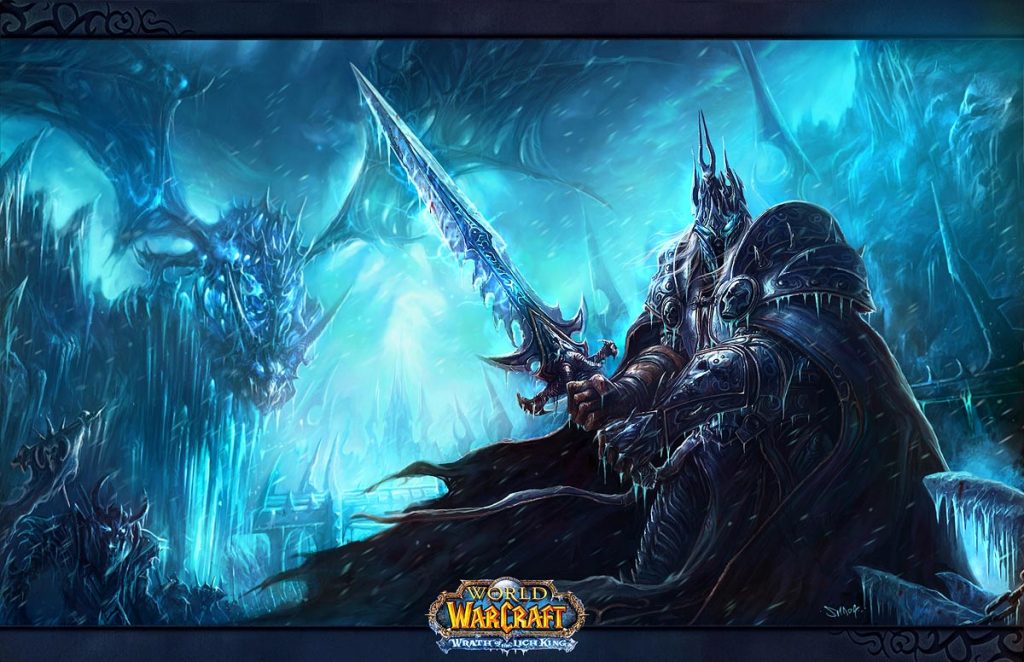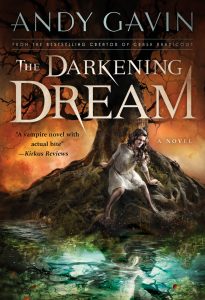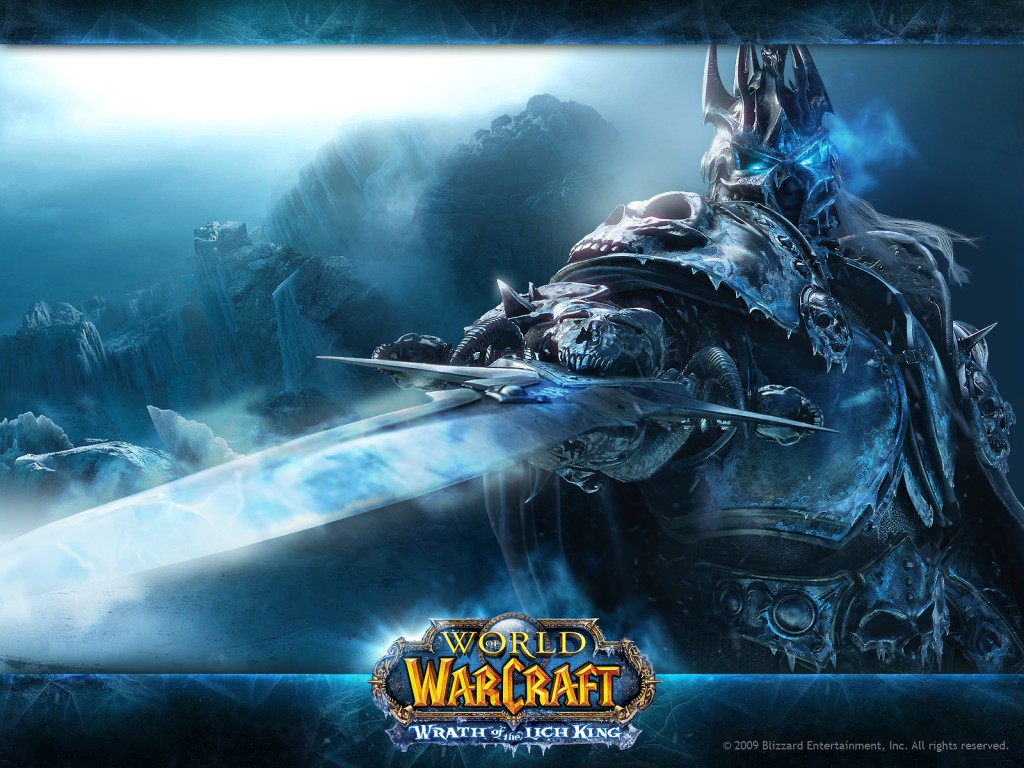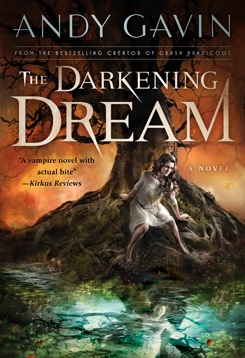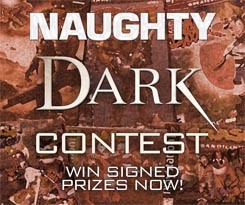…continued from my coverage of the WOW Burning Crusade endgame.
The months leading up to the launch of Wrath of the Lich King were very exciting for me. First of all, my son was about to be born — in fact, he was scheduled to arrive just days after LK! And on a WOW front, Blizzard pushed the 3.0.x series of patches 4-6 weeks in advance of the expansion itself.
Before Heading North
Patch 3.0.x introduced the most sweeping changes of any infrastructure patch yet — and a lot of it was content of a sort. We got the usual full reworking of the classes and talent trees. This didn’t itself add any content, but yet it did. One consequence was a substantial increase in average dps output. All of a sudden, impossible raid bosses were now difficult… but doable. Our guild, which previously could kill Arche and Illidan on a good night, starting trouncing them and moving through Sunwell.
Over Achiever
Just as significant, was the brand new achievement system. Blizzard hardly invented achievements, but in their usual fashion, took what other did and did it better. The WOW achievement system launched with an overwhelming array of achievements and meta-achievements (more than 500). These didn’t give you any in-game advantage, but they sure felt cool and opened up fun vanity awards such as pets, mounts, and titles.
Even before LK itself shipped, I spent countless hours grinding out certainly achievement types. I’m a completist (i.e. type A) and I thought I’d knocked off almost every quest in Azeroth. Well, it still took me about three weeks to complete the Azeroth and Outland sections of Loremaster (an achievement and title awarded for doing every quest in the game).
The patch also moved pets, mounts, and currencies into new interface tabs. This opened up a lot of bag space and made it reasonable to invest heavily in collecting the cute little beasties. I was already a bit of a pet collector, but in the month or so before LK went nuts with grinding out every cool pet I could. Unless the grind was particularly horrific (Hyacinth Macaw), I got it. This included rarities like the Black Tabby Cat and Disgusting Oozeling. I always had the most pets of anyone I knew.
One of the great things about the achievement system was that it opened up countless different avenues of time investiture to choose from. I worked on questing, dungeons, seasonal events, and pets. Others might have worked on PVP, reputation, or whatever. Every aspect of the game was covered and it brought new life into many of them.
Holiday Fun
Patch 3.0.x shipped during the busy WOW holiday season that includes Brew Fest, Hallows Eve, Winter’s Veil etc. In the Vanilla period, I treated holidays as curious decoration. A few minutes doing the Winter’s Veil chains in 2005 showed them to yield… pretty much nothing and that was the last of it.
During Burning Crusade, Blizzard introduced the first holiday boss, the Headless Horseman. Not only was he a fun new boss, but he dropped a bit of epic loot. Serious toons like my Warlock had much better gear anyway, but he was great for grabbing a good ring for your alt. He was so popular that the Dire Brew boss, Ahune, and the Valentine’s boss soon followed.
But achievements took the holidays to a new level. They provided a road map of weird activities during each holiday. And if you did everything for the holiday, you got a title. And, even better, if you did everything for every holiday (which took a year) you could earn a 310% speed special purple dragon mount! At the time, these fast mounts were very hard to come by. Usually only the most hardcore raiders could hope to earn one.
So that Halloween I tried (successfully) to finish the holiday meta, which was in those days pretty f**king stressful. Blizzard has since made them much easier, but that first year there were some achievements that required a lot of luck and a lot of grinding. To maximize your odds, you had to really knock everything out as soon as you could during the holiday in case there was some troublesome random number based task. Also, at the beginning of the holiday, the crowds generally made most things easier. And there were some serious crowds. The holidays were never too popular before, but the rush to earn the achievements brought out a serious frenzy of players.
The Big Day
Burning Crusade was so cool that I was very excited for Lich King. Plus, the trailer was badass. I even waited outside at midnight to buy my pre-ordered Collector’s Edition. This was the last time I bothered. I still got CEs (for the pets) but I just ordered them from Amazon and waited the extra 12 hours.
http://www.youtube.com/watch?v=eMRhnC4-QGQ
I bought a new Macbook Pro a couple weeks before just to make sure I could play in the hospital with my tired wife and freshly minted son. This actually worked pretty well, newborns sleep a lot. 🙂
Heroic Faceroll
Anyway: the endgame.
Historically, dungeons made up the bulk of early endgame play. I dinged level 80 and some guildies invited me into a Heroic. Yeah, that’s right. No keys. No attunement. No grinding to Revered reputation. Just hop right in… and crush the dungeon in 20-30 minutes!
Huh? Not only were dungeons short, which was obvious even while leveling, but even the Heroics were incredibly easy. I never ran a single level 80 non-heroic instance. There was no need. Your quest gear would easily carry you in Heroics, and the rewards were much better. Better gear, more rep, and more badges (more on that later). Crowd control was completely useless. Pats? Who cares? The tank just grabbed a pile of mobs, you nuked them down, repeat.
A few specific fights were kinda hard at the beginning of the expansion: Skadi in Utgrade Pinnacle, and the final bosses of Oculus and Halls of Lightning. As a consequence, those last two were the least popular instances.
For those that liked a challenge, every dungeon had 2-4 funky achievements that involved weird ways of beating bosses. Some were quite hard and almost all required a group that played together regularly. Getting all these achievements earned you a cool mount and provided quite a time sink for the dedicated few.
Badges for Everyone
LK took the badge system developed in BC to a whole new level. It introduced two (soon to grow to four, then six) badge currencies for PVE alone. Badges of Heroism came from 5 man Heroics and 10 man raids and Badges of Valor from 25 man raids. Both allowed the purchase of good endgame gear. The lower currency epics were the same grade as the heroic epics. The better currency similar to the first tier of 25 man raiding.
In practice, this meant that you wanted lots and lots of badges at first. For several weeks, even Heroism badges were useful. Soon enough, at least for classes with damage only specs, you wouldn’t need those so much (except maybe for the new Heirloom gear). But Valor badges, you could always use those. And even the heroics let you earn two of those a day by running the “daily dungeon.”
All of this meant that it was advantageous to run 5 man dungeons long after you needed anything the dungeons themselves dropped. As they were easy to begin with and most players out-geared them rapidly, they became mindless zergs (see below).
Rep Hubs & Tabards
LK gave us more reputations than ever. Most zones had one. Some of these had small clusters of repetitive daily quests you could use to grind to exalted. Those with quests mostly yielded cosmetic or profession benefits. The grinds were fairly short, usually around 2 weeks.
While in BC each dungeon yielded a specific rep, LK instituted tabards that allowed you to earn the rep of your choice while running Heroics. This meant that it was only a matter of time before you brought all tabard reps to exalted, but usually, by the time it happened, you didn’t need much they had to offer. Each rep did have an epic or two, and so the first couple were useful, particularly if they had dailies to speed up the process.
Professions, both of the crafting sort and the basic cooking and fishing, usually each got a single daily quest. Instead of having recipes drop all over the world randomly, the were usually sold by the profession vendor in exchange for a new currency given by the profession daily. So, for cooking, you ran your quick little daily, and every couple of days, bought a new recipe. This all made it easier and more predictable to collect your patterns, but it also took most of the excitement out of the process.
Overall, after about a month, you were done with the dailies (other than the daily dungeon).
Even Raids can be Easy
At launch, LK was a little shy on raid content. It gave us two single boss raids: Obsidian Sanctum and Eye of Eternity and one big one. Naxxramas 2.0 had 15 bosses!
These three raids could be run either in 10 man or 25 man configurations. You could run both each week if you liked. I was never much for 10 man because the loot was considerably worse and they dropped the lower badge type (which I always had in excess). 10 man was a bit easier for most fights. OS was very easy normally (there was a progressive way to make it harder) and The Eye was harder, but not too hard. Both were short.
Even Naxx was tuned way easier than previous raids. But it was long. At this stage, Naxx 25 held a lot of good gear, but it quickly became quite a slog, particularly if you ran BOTH the 10 man and 25 man versions. It only took our guild about a month to have it on farm (where every boss died every week). Long before the next raid tier launched, we were pretty darn sick of Naxx. The revised Vanilla design was still excellent, and few players had seen the instance the first time around, but still, it felt a little lazy. Even the gear looked the same (although it was updated for level 80)!
The clever achievements did add a little fun. Title based ones like “The Undying” (where you cleared Naxx without any deaths) were very popular among the skilled.
PVP backburner
In BC, although tedious, PVP was a good way to progress your PVE game. LK saw the introduction of gear that was so heavily slanted toward PVP as to be nearly useless in PVE (compared to easy to get badge gear). This, combined with crazy battleground fatigue from BC, insured I never ran a battleground during the whole of LK (except for a few holiday achievements).
One exception was Wintergrasp, the new world PVP zone. Now, I couldn’t have cared less about WG itself, and found it pretty boring. But it was useful to run it occasionally so as to be in the right place at the right time to catch a group for the new PVP raid instance. This dungeon, located under WG keep, was available to the faction that most recently won the zone and contained at first one, then with each new tier, more raid bosses. These bosses were very easy, trivial to PUG, and dropped a mix of PVE and PVP gear, including the pants and gloves from each tier!
Getting lucky here was an easy way to save badges or DKP (Dragon Kill Points used to partition guild loot).
3 Drakes, Ulduar and crazy hard modes
The early raids were easy by design. Blizzard wanted a wider range of players to experience the raiding content. But OS had an unusual mechanic for making it harder. You could kill Sartharion’s 3 drakes before the boss, and take him down easy, or you could leave up one, two, or three drakes. For each extra drake you fought at the same time as the boss, the loot was better. This itself didn’t make much of a gearing difference, but if you killed him with all three drakes up (3D) you got an elitist title and a chance at a cool specialty mount.
In the spring of 2009, when the next big raid, Ulduar, shipped, it took hard modes a step further. Ulduar was another giant raid with 14 bosses. It was long, involved, and pretty hard even normally. At least, the last third was. Some people loved it. I thought it was too big and took too long. And I really wasn’t a fan of the first boss’s tedious vehicle mechanic. A few of the bosses also had unusual “hard modes” like OS where you could trigger a different, much much harder fight. We attempted these a number of times but our guild only really managed hard modes on Flame Leviathan and XT-002. The hard modes dropped gear a half tier better.
If you more or less did all of these hard modes you could open up Algalon, and extra boss who was really cool, and really really hard. You only had an hour a week to fight him too, but killing him awarded a highly prestigious title.
Badge Inflation
During the LK period, Blizzard experimented with the badge system. At first, you had to manually loot your badges off bosses. It was easy to forget, and so they then added an “auto loot” that forced them into your bag. This worked, but was buggy and often caused server instabilities. Later, they moved the badges from your bags into a special currency section and added a system by which they would be automatically credited as soon as the boss was downed. This included a system to issue rewards when the final boss of a dungeon was cleared.
Additionally, as each successive raiding tier was released, it became necessary to make available new currencies. Players would have accumulated surplus badges in the older tiers, and to keep things fair they introduced new pairs of currencies (one for dungeons and 10 man and one for 25 man). Limited means of down converting newer currencies into older ones were experimented with. By the end of the expansion this became an unwieldy collection of 6-8 different badge currencies just for LK, so while the basic scheme was to be retained in Cataclysm, some cleanups were in order.
Overall, the badge system did remove some of the frustration inherent in the random nature of dropped loot. It helped you make steady progress regardless of your raiding situation. In the Vanilla/BC days this had been vastly more susceptible to your spec and how often your guild ran farm content. If you played an “easy to gear” spec like Holy Paladin (who has healing plate all to itself) previous tier or farm instances would literally shower you with loot. In the days when a Holy Pally could heal effectively in any armor type, you could passably gear one in just a run or two of a big instance like Kara or Naxx if other healers didn’t need the loot.
Another Hub
Summer saw another interim patch with a new rep, a new daily quest hub, a new 5 man, a revised level 80 version of Ony, and a new mid-sized raid. Grinding the rep mostly got you cosmetic gains again, but the new 5 man was useful in gearing alts as it dropped entry level epics very easily. Both the 5 man and the raid were lazy designs and took place inside the same basic arena map. You fought a series of bosses with no trash.
Lazy and uninspired as this was, it was efficient gearing wise.
10 + 25 + heroic 10 + heroic 25 = Burnout
The raid, Trial of the Crusader, had 5 bosses and could be run in 30-40 minutes. Blizzard tried something new with raid difficulty variations. TOC had 4 modes: 10 man, 25 man, 10 man heroic, and 25 man heroic. You could run all four modes every week! Because of the complex array of gear levels in Ulduar (10 man, 25 man, and their respective hard modes ranged from 213 – 239) there was rapid gear inflation going into TOC. 10 man was 232, 10 man heroic and 25 man 245, and 25 man heroic 258.
This all meant that almost anything from TOC was better than Ulduar (and of course Naxx and the like). 25 man regular was pretty easy and its 245 stuff was even better than Algalon loot. The place was fast and pretty easy. 10 man heroic wasn’t even THAT hard once you had 25 man gear. 25 man heroic was pretty hard, but not crazy.
All in all, a total loot fest that invalidated all the previous LK raiding content. It was also mind numbing because there was incentive to run it on 3-4 modes per week. Sometimes I’d run all four in one day, then switch over to an alt and run a few more! Everyone was very rapidly and totally burned out on the place. Good thing there wasn’t any trash.
Ice Crown Patch, Magister’s Terrace redux
The penultimate major patch of LK introduced a lot of content. The giant Ice Crown Citadel raid opened along with three new 5 man dungeons. These followed the model set by the Isle of Quel’Danas in BC and were both more difficult and dropped far better loot. In fact, they dropped 232 in Heroic, which was equivalent to TOC 10 man. This continued to devalue loot from the original dungeons and first two tiers of raiding (Naxx and Uld). You could gear new tunes very quickly and effectively in 232 and 245 by a combination of these new dungeons and TOC farm runs.
Which prepared you well to run ICC for 258 and 264 loot. The first four bosses of ICC were very easy and the instance opened in waves. Average gear levels surged. Still, the middle and ending ICC bosses were not so easy and again separated out the solid and just average guilds. This gigantic instance was to be the main source of endgame raiding for the next year to come. The only exception was a one boss side raid that came in Spring of 2010. After a few months of endlessly repeating ICC many players moved on to alts or other games.
The creative hard modes of Ulduar must have required too much developer effort and constraint, so ICC retained the preselected Heroic mode like TOC, but Blizzard collapsed the normal and Heroic raid lockouts so you could run it at most twice on one character. This manual switch between difficulties is still the case today in Mists of Pandaria.
Dual Spec
LK also introduced Dual Specialization. This continued Blizzard’s push toward quicker and easier by allowing your character to have two entirely different talent/action bar/glyph setups. This was most useful for tanks and healers as they could split between a raid and farming spec. Die hard PVP players could also split that way. For PVE only dps classes like my Warlock it was a nicety, but not essential. Still, it supported the varied play-style agenda that Blizzard had and has been pushing.
The Dungeon Finder
The ICC patch also brought one of the biggest changes to date: the dungeon finder. Previously, to run a 5 man dungeon, players had to assemble a group manually via global chat channels (idiotically confined to capital cities), all players came from the same server, and had to journey across the world to the instance. Once three arrived, it was possible to summon the other two.
The dungeon finder allowed players to queue for a category or specific instance and then instantly teleport into the dungeon together. It even drew from a pool of servers. In practice, this was nearly instant for tanks and healers and 10-15 minutes for dps. You could continue questing or dailies while waiting and you could replace players fairly quickly if one bailed. Afterward, you could teleport back to the exact spot you left.
Given that assembling a group required 1-2 hours of broadcasting in a capital city, this was enormously convenient. It meant that you could queue while playing, and then when ready, pop in, run a dungeon, and pop back with very little down time. But most players were from different servers and this meant that the incentive to stay with a problematic (or slightly problematic) group was very low. Gone was accountability, the sense that you would be branded lame by other players on the server. Gone was the camaraderie of making in-game friends during successful (and not so successful) runs. Server identity continued to erode.
Zerg for all
The combination of factors introduced in LK led to the rise of “zerg dungeon farming”:
- Easier Heroic dungeons
- Badge rewards from bosses
- Daily rewards making it valuable to run instances long after players outgeared the instances and their direct loot
- The dungeon finder allowed for rapid forming of runs
The net effect of all this was that late period LK dungeons became a sort of silent and hurried race through the instance. In the typical run, the tank charged forward, grabbing mobs willy nilly while dps aoed them down and healers barely had to do anything. Boss mechanics became nearly irrelevant. Subtlety and strategy were abandoned.
Conclusion
By the end of Lich King, nearly all the major mechanics that Blizzard introduced during the course of WOW evolution had come into play: Badges, the dungeon finder, dailies, reputation hubs, tier acceleration, split difficulties (heroic and normal), split raid sizes (10 and 25), profession currencies, separate pvp/pve tracks, achievements, and more. This endgame toolbox allowed for a wide range of player activities and for fairly continuous rewards along many of them. It allowed for much of the player base to experience raid content and tried to avoid sudden progress blockages for different player types.
The general feel and flavor of Lich King was also fantastic, but there were problems. In the name of accessibility, the epic nature of many encounters was sorely eroded. Numerous difficulty and size tracks and long reuse of content led to fairly extreme burnout. Overgearing of instances watered down designs that were already fairly forgiving and removed any strategic play in dungeons (i.e. crowd control and the like). In the name of balance, loot and rewards became monotonous and chore-like. Raid content was too sparse and too easy to cover the two year expansion. More burnout ensued.
I liked the expansion, and I give Blizzard an A for effort. They aren’t afraid to experiment and try to move the game in a better direction, even if those changes sometimes have negative consequences. They are particularly willing to overhaul class mechanics again and again. Overall, the LK endgame gave you more to do than ever before.
| WOW Endgame series: Vanilla, Burning Crusade, Lich King, Cataclysm, and Pandaria. or read about Mists of Pandaria leveling. Latest hot post: Reaper of Souls Analysis! If you liked this post, follow me at: My novels: The Darkening Dream and Untimed |

